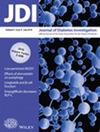Clinical use and monitoring of adverse effects of sodium-glucose cotransporter-2 inhibitors in persons with type 1 diabetes mellitus
Abstract
Aims
This study aimed to evaluate the factors contributing to insulin dosage adjustment and the risk of sodium-glucose cotransporter-2 inhibitor (SGLT2i) discontinuation in persons with type 1 diabetes mellitus (T1DM) starting SGLT2i therapy in clinical practice.
Materials and Methods
This retrospective study used the electronic medical record-based survey data of 49 patients attending our hospital between December 2018 and October 2021 to investigate the clinical use and adverse effects of SGLT2i in persons with T1DM starting SGLT2i.
Results
Upon SGLT2i initiation, there were five patients in the favorable glycemic control group (HbA1c < 7.5%) and 44 patients in the poor glycemic control group (HbA1c ≥ 7.5%); few patients in the favorable glycemic control group reduced total daily insulin dose according to the recommendation, while 75% of patients in the group with poor glycemic control followed the guideline. Moreover, 60% of patients had hypoglycemia before the introduction of SGLT2i; additionally, among patients with no hypoglycemia before introduction, 50% had hypoglycemia after introduction. The group with hypoglycemia after induction tended to have longer diabetes duration and lighter body weight compared to the group without hypoglycemia. Multiple regression analysis revealed that diuretic use was an independent risk factor for discontinuation of SGLT2i (partial regression coefficient = 0.819, P = 0.001).
Conclusions
When initiating SGLT2i in T1DM patients, it is important to evaluate glycemic control and adjust insulin dosage based on weight and diabetes duration to reduce hypoglycemia frequency.


 求助内容:
求助内容: 应助结果提醒方式:
应助结果提醒方式:


